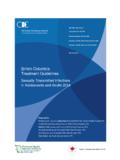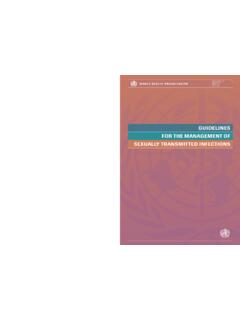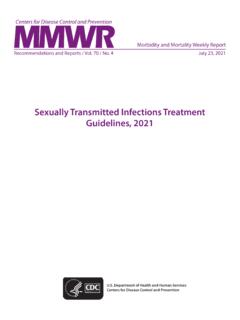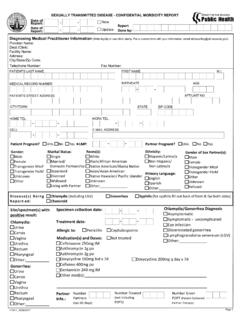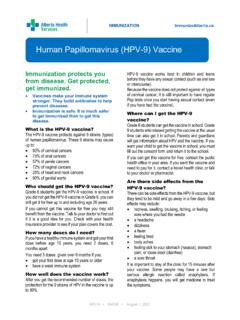Transcription of Sexually Transmitted Diseases Treatment Guidelines, 2015
1 Please note: An erratum has been published for this issue. To view the erratum, please click here. Morbidity and Mortality Weekly Report Recommendations and Reports / Vol. 64 / No. 3 June 5, 2015. Sexually Transmitted Diseases Treatment Guidelines, 2015. Department of Health and Human Services Centers for disease Control and Prevention Recommendations and Reports CONTENTS CONTENTS (Continued). Gonococcal 60. Diseases Characterized by Vaginal 69. Clinical Prevention Bacterial 69. Special 72. Emerging 17 Vulvovaginal 75. Hepatitis 17 Pelvic Inflammatory 78. Mycoplasma 20 82. HIV Infection: Detection, Counseling, and 21 Human Papillomavirus 84. Diseases Characterized by Genital, Anal, or Perianal 25 Anogenital 86. 26 HPV-Associated Cancers and 90. Genital HSV 27 Viral 94. Granuloma Inguinale (Donovanosis).. 32 Hepatitis 94. Lymphogranuloma 33 Hepatitis 95. 34 Proctitis, Proctocolitis, and Management of Persons Who Have a History of Penicillin 49 Ectoparasitic Diseases Characterized by Urethritis and 51 Pediculosis 51 Nongonococcal 52 Sexual Assault and Abuse and 53 Chlamydial 55 Terms and Abbreviations Used in This The MMWR series of publications is published by the Center for Surveillance, Epidemiology, and Laboratory Services, Centers for disease Control and Prevention (CDC), Department of Health and Human Services, Atlanta, GA 30329-4027.
2 Suggested citation: [Author names; first three, then et al., if more than six.] [Title]. MMWR Recomm Rep 2015;64(No. RR-#):[inclusive page numbers]. Centers for disease Control and Prevention Thomas R. Frieden, MD, MPH, Director Harold W. Jaffe, MD, MA, Associate Director for Science Joanne Cono, MD, ScM, Director, Office of Science Quality Chesley L. Richards, MD, MPH, Deputy Director for Public Health Scientific Services Michael F. Iademarco, MD, MPH, Director, Center for Surveillance, Epidemiology, and Laboratory Services MMWR Editorial and Production Staff (Serials). Sonja A. Rasmussen, MD, MS, Editor-in-Chief Martha F. Boyd, Lead Visual Information Specialist Charlotte K. Kent, PhD, MPH, Executive Editor Maureen A. Leahy, Julia C. Martinroe, Christine G. Casey, MD, Editor Stephen R. Spriggs, Visual Information Specialists Teresa F. Rutledge, Managing Editor Quang M. Doan, MBA, Phyllis H. King David C. Johnson, Lead Technical Writer-Editor Terraye M. Starr, Information Technology Specialists Rachel J.
3 Wilson, Project Editor MMWR Editorial Board William L. Roper, MD, MPH, Chapel Hill, NC, Chairman King K. Holmes, MD, PhD, Seattle, WA. Matthew L. Boulton, MD, MPH, Ann Arbor, MI Timothy F. Jones, MD, Nashville, TN. Virginia A. Caine, MD, Indianapolis, IN Rima F. Khabbaz, MD, Atlanta, GA. Jonathan E. Fielding, MD, MPH, MBA, Los Angeles, CA Patricia Quinlisk, MD, MPH, Des Moines, IA. David W. Fleming, MD, Seattle, WA Patrick L. Remington, MD, MPH, Madison, WI. William E. Halperin, MD, DrPH, MPH, Newark, NJ William Schaffner, MD, Nashville, TN. Recommendations and Reports Sexually Transmitted Diseases Treatment Guidelines, 2015. Prepared by Kimberly A. Workowski, MD1,2. Gail A. Bolan, MD1. 1 Division of STD Prevention National Center for HIV/AIDS, Viral Hepatitis, STD, and TB Prevention 2 Emory University, Atlanta, Georgia Summary These guidelines for the Treatment of persons who have or are at risk for Sexually Transmitted Diseases (STDs) were updated by CDC after consultation with a group of professionals knowledgeable in the field of STDs who met in Atlanta on April 30 May 2, 2013.
4 The information in this report updates the Sexually Transmitted Diseases Treatment Guidelines, 2010 (MMWR Recomm Rep 2010;59 [No. RR 12]). These updated guidelines discuss 1) alternative Treatment regimens for Neisseria gonorrhoeae;. 2) the use of nucleic acid amplification tests for the diagnosis of trichomoniasis; 3) alternative Treatment options for genital warts;. 4) the role of Mycoplasma genitalium in urethritis/cervicitis and Treatment -related implications; 5) updated HPV vaccine recommendations and counseling messages; 6) the management of persons who are transgender; 7) annual testing for hepatitis C in persons with HIV infection; 8) updated recommendations for diagnostic evaluation of urethritis; and 9) retesting to detect repeat infection. Physicians and other health-care providers can use these guidelines to assist in the prevention and Treatment of STDs. Introduction on the basis of their expertise in the clinical management of STDs. Members of the multidisciplinary workgroup included The term Sexually Transmitted Diseases (STDs) refers to representatives from federal, state, and local health departments.
5 A variety of clinical syndromes and infections caused by public- and private-sector clinical providers; clinical and basic pathogens that can be acquired and Transmitted through sexual science researchers; and numerous professional organizations. activity. Physicians and other health-care providers play a All workgroup members disclosed potential conflicts of interest;. critical role in preventing and treating STDs. These guidelines several members of the workgroup acknowledged receiving for the Treatment of STDs are intended to assist with that effort. financial support for clinical research from commercial Although these guidelines emphasize Treatment , prevention companies. All potential conflicts of interest are listed at the strategies and diagnostic recommendations also are discussed. end of the workgroup member section. This document updates CDC's Sexually Transmitted Diseases In 2012, CDC staff and workgroup members were charged Treatment Guidelines, 2010 (1). These recommendations should with identifying key questions regarding Treatment and be regarded as a source of clinical guidance rather than prescriptive clinical management that were not addressed in the 2010.
6 Standards; health-care providers should always consider the STD Treatment Guidelines (1). To answer these questions clinical circumstances of each person in the context of local disease and synthesize new information available since publication of prevalence. These guidelines are applicable to any patient-care setting the 2010 Guidelines, workgroup members collaborated with that serves persons at risk for STDs, including family-planning CDC staff to conduct a systematic literature review using clinics, HIV-care clinics, correctional health-care settings, private an extensive MEDLINE database evidence-based approach physicians' offices, Federally Qualified Health Centers (FQHCs), ( , using published abstracts and peer-reviewed journal and other primary-care facilities. These guidelines focus on Treatment articles). These reviews also focused on four principal outcomes and counseling and do not address other community services and of STD therapy for each individual disease or infection: interventions that are essential to STD/HIV prevention efforts.
7 1) Treatment of infection based on microbiologic eradication;. 2) alleviation of signs and symptoms; 3) prevention of sequelae;. 4) prevention of transmission, including advantages such Methods as cost-effectiveness and other advantages ( , single-dose These guidelines were developed by CDC staff and an formulations and directly observed therapy) and disadvantages independent workgroup for which members were selected ( , side effects) of specific regimens. The outcome of the literature review informed development of background Corresponding preparer: Kimberly A. Workowski, National Center materials, including tables of evidence from peer-reviewed for HIV/AIDS, Viral Hepatitis, STD, and TB Prevention. Telephone: publications summarizing the type of study ( , randomized 404-639-1898; E-mail: controlled trial or case series), study population and setting, MMWR / June 5, 2015 / Vol. 64 / No. 3 1. Recommendations and Reports treatments or other interventions, outcome measures assessed, Clinical Prevention Guidance reported findings, and weaknesses and biases in study design and analysis.
8 The prevention and control of STDs are based on the In April 2013, the workgroup's research was presented at following five major strategies (5): an in-person meeting of the multidisciplinary workgroup accurate risk assessment and education and counseling of members. Each key question was discussed, and pertinent persons at risk on ways to avoid STDs through changes publications were reviewed in terms of strengths, weaknesses, in sexual behaviors and use of recommended prevention and relevance. The workgroup evaluated the quality of services;. evidence, provided answers to the key questions, and rated pre-exposure vaccination of persons at risk for vaccine- the recommendations based on the United Services Preventive preventable STDs;. Services Task Forces (USPSTF) modified rating system (http:// identification of asymptomatically infected persons and ). persons with symptoms associated with STDs;. The discussion culminated in a proposal of recommendations effective diagnosis, Treatment , counseling, and follow up to be adopted for consideration by CDC.
9 (More detailed of infected persons; and description of the key questions, search terms, and systematic evaluation, Treatment , and counseling of sex partners of search and review process is available at persons who are infected with an STD. std/tg2015 ). Following the April meeting, the literature was searched periodically by CDC staff to identify STD/HIV Risk Assessment subsequently published articles warranting consideration by Primary prevention of STDs includes performing an the workgroup either through e-mail or conference calls. assessment of behavioral risk ( , assessing the sexual CDC developed draft recommendations based on the behaviors that may place persons at risk for infection) as workgroup's proposal. To ensure development of evidence- well as biologic risk ( , testing for risk markers for HIV. based recommendations, a second independent panel of public acquisition or transmission). As part of the clinical encounter, health and clinical experts reviewed the draft recommendations.
10 Health-care providers should routinely obtain sexual histories The recommendations for STD screening during pregnancy, from their patients and address risk reduction as indicated cervical cancer screening, and HPV vaccination were developed in this report. Guidance for obtaining a sexual history is after CDC staff reviewed the published recommendations available on the CDC Division of STD Prevention resource from other professional organizations, including the American page ( ) and College of Obstetricians and Gynecologists (ACOG), in the curriculum provided by CDC's STD/HIV Prevention USPSTF, American Cancer Society (ACS), American Society Training Centers ( ). Effective for Colposcopy and Cervical Pathology (ASCCP), and the interviewing and counseling skills characterized by respect, Advisory Committee on Immunization Practices (ACIP) as compassion, and a nonjudgmental attitude toward all part of the initial review process. The sections on hepatitis B patients are essential to obtaining a thorough sexual history virus (HBV) and hepatitis A virus (HAV) infections are based and delivering effective prevention messages.











